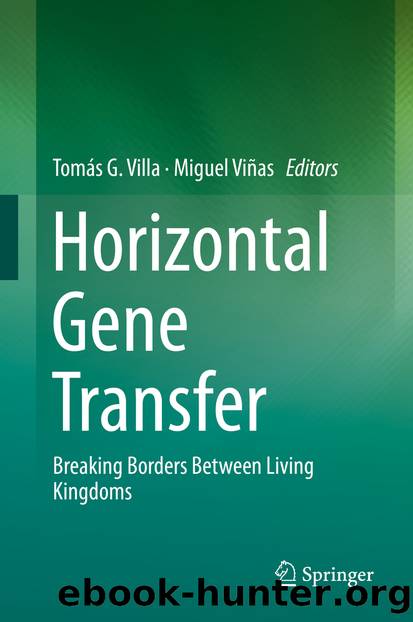Horizontal Gene Transfer by Unknown

Author:Unknown
Language: eng
Format: epub
ISBN: 9783030218621
Publisher: Springer International Publishing
5 Bioinformatic Approaches to the Prediction of HGT
Cataloguing the specific loci involved in functional HGT in Metazoa, and thus measuring rates and patterns of HGT, depends sensitively on the methods used to identify HGT candidates in genomes and transcriptomes. These methods have developed rapidly in the last decade as more and more complete metazoan and eukaryote genomes have been sequenced, providing essential background in which to embed both analytic strategies and improve the credibility of predictions.
In bacteria, recently transferred genomic fragments can be distinguished from their new host genome by a range of metrics, including GC content and additional k-mer spectra, amongst which tetranucleotide content appears most informative, CG skew in relation to the surrounding genome, and codon usage pattern. In addition, sequence similarity and phylogenetic analyses comparing the candidate HGT locus to the genomes of other, potential donor species can be used to show phylogenetic incongruence compared to the bulk genome. Less emphasis is place in bacterial HGT analysis on more subtle but essential components of amelioration, such as acquisition of promoter elements optimally functional in the new host cell. Bacteria have very large effective population sizes, and thus amelioration at the level of GC content, k-mer spectra, CG skew and codon usage can be relatively rapid. The enduring signal of (relatively) ancient HGT is phylogenetic evidence of incongruence. An array of methods have been developed for HGT detection in bacteria (Zaneveld et al. 2008).
Tools developed for bacterial metagenomics and detection of HGT in bacteria applications have been very effectively used in contamination detection in eukaryotic genome assemblies (including the draft genome of the tardigrade H. exemplaris) and can aid HGT detection (Eren et al. 2015; Clasen et al. 2018). The EuGI toolkit, developed from a bacterial HGT detection program, uses tetranucleotide spectral composition to identify extended regions that are likely to derive from HGT events (Clasen et al. 2018). By identifying long (~100 kb) segments of assembled genomes that have tetranucleotide spectra that differ from that found in the local genomic region, and from the genome as a whole, EuGI was able to identify recent HGT events in protist, fungal and non-vertebrate genomes. Tetranucleotide frequency spectra are also used by the Anvi’o toolkit (Eren et al. 2015) to build complex discriminators to separate segments that derive from distinct genomic sources and can identify recent HGTs. We note that tetranucleotide spectra perform poorly on short sequences and are also likely to fail to identify older, ameliorated HGTs.
In eukaryotes, functional integration of an HGT from a bacterial source is more difficult than simple acquisition of foreign DNA, as it requires acquisition of (in most cases) spliceosomal introns, mRNA initiation and polyadenylation signals and integration into the more complex transcriptional landscape of its host. Horizontal acquisition from other eukaryotes requires less amelioration. It is important to note that, for example, different eukaryotic groups can have very different spliceosomal intron systems and thus that donor introns may not be recognised by the recipient machinery. The lower effective population sizes of most eukaryotes mean the amelioration processes must be slower than is observed in bacteria.
Download
This site does not store any files on its server. We only index and link to content provided by other sites. Please contact the content providers to delete copyright contents if any and email us, we'll remove relevant links or contents immediately.
| Administration & Medicine Economics | Allied Health Professions |
| Basic Sciences | Dentistry |
| History | Medical Informatics |
| Medicine | Nursing |
| Pharmacology | Psychology |
| Research | Veterinary Medicine |
Tuesdays with Morrie by Mitch Albom(4720)
Yoga Anatomy by Kaminoff Leslie(4327)
Science and Development of Muscle Hypertrophy by Brad Schoenfeld(4101)
Bodyweight Strength Training: 12 Weeks to Build Muscle and Burn Fat by Jay Cardiello(3936)
Introduction to Kinesiology by Shirl J. Hoffman(3739)
How Music Works by David Byrne(3217)
Sapiens and Homo Deus by Yuval Noah Harari(3023)
The Plant Paradox by Dr. Steven R. Gundry M.D(2574)
Churchill by Paul Johnson(2537)
Insomniac City by Bill Hayes(2514)
Coroner's Journal by Louis Cataldie(2451)
Hashimoto's Protocol by Izabella Wentz PharmD(2345)
The Chimp Paradox by Peters Dr Steve(2331)
The Universe Inside You by Brian Clegg(2112)
Don't Look Behind You by Lois Duncan(2099)
The Immune System Recovery Plan by Susan Blum(2037)
The Hot Zone by Richard Preston(1993)
Endure by Alex Hutchinson(1986)
Woman: An Intimate Geography by Natalie Angier(1904)
